The Jellyfish Galaxy is a barred spiral galaxy located approximately 220 million light-years away in the constellation Triangulum Australe (the Southern Triangle). The unusual galaxy is a member of the Norma Cluster of galaxies (Abell 3627). It is listed as ESO 137-001 in the European Southern Observatory Catalogue.
The Jellyfish Galaxy is comparable in size to the Milky Way. It has a diameter of 100,000 light years. It is slightly less massive than our galaxy. It lies near the centre of the Norma Cluster, only 14.5 arcminutes (200 kpc) from the cluster’s central galaxy, ESO 137-006.
ESO 137-001 is the prototypical jellyfish galaxy. It has blue tendrils of star formation that trail away from its central region, appearing like the tentacles of a jellyfish. The tail of hot gas has been stripped from the galaxy through a process known as ram pressure stripping.
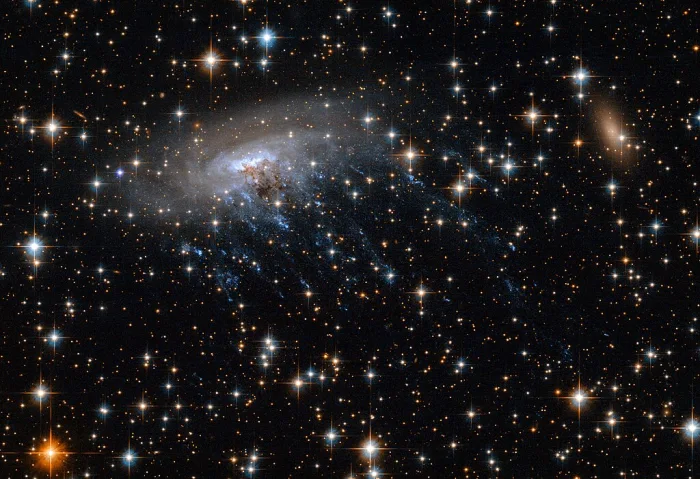
This Hubble image shows spiral galaxy ESO 137-001, framed against a bright background as it moves through the heart of galaxy cluster Abell 3627. This image not only captures the galaxy and its backdrop in stunning detail, but also something more dramatic — intense blue streaks streaming outwards from the galaxy, seen shining brightly in ultraviolet light. These streaks are in fact hot, wispy streams of gas that are being torn away from the galaxy by its surroundings as it moves through space. This galactic disrobing is due to a process known as ram pressure stripping — a drag force felt by an object moving through a fluid. Image credit: NASA, ESA; Acknowledgements: Ming Sun (UAH), and Serge Meunier (CC BY 4.0)
Ram pressure stripped galaxies commonly have these tails and are collectively known as jellyfish galaxies. They are typically galaxies that fall toward the centres of massive galaxy clusters. They have highly asymmetric morphologies with long tails of debris.
The Jellyfish Galaxy is speeding at 1,900 km/s towards the centre of the Norma Cluster. As it plunges towards the cluster’s centre, the galaxy moves through the hot intracluster medium and is greatly affected by it. Ram pressure stripping is the result of the galaxy’s speed combined with the density of the gas in the cluster. The hot intergalactic gas in Abell 3627 has a temperature of around 100 million K. It creates drag forces and strips gas out of the Jellyfish Galaxy, causing the formation of the large trailing tails.
As the cold gas is removed from the Jellyfish Galaxy, star formation is slowed down, and the appearance of the galaxy’s inner spiral arms and bulge is greatly affected. The galaxy’s ability to form new stars will ultimately be halted as the cosmic Jellyfish is stripped of the raw materials essential for star formation and assimilated into the larger cluster of galaxies.
The giant tail of hot gas trailing behind the Jellyfish Galaxy is visible in X-ray light. Surprisingly, it is a site of star formation. The tail stretches 260,000 light-years across, spanning about 2.5 times the galaxy’s size. It hosts bright, compact knots of photoionized gas, which indicate the presence of young stars.
Observations with the Infrared Spectrograph (IRS) aboard the Spitzer Space Telescope and the Atacama Pathfinder Experiment (APEX) in 2010 and 2014 revealed that both the disk and tail of the Jellyfish Galaxy contained abundant cold, dense gas in which new stars were forming. Observations of the star forming regions in ESO 137-001 with the Advanced Camera for Surveys (ACS) on board the Hubble Space Telescope (HST) showed stellar regions with a mass of about 104 solar masses and ages of up to 100 million years.
Astronomers were puzzled by the star formation in the tail because the ram pressure stripping process should have heated the gas in the tail. The gas had to first cool down in order to condense and form new stars.
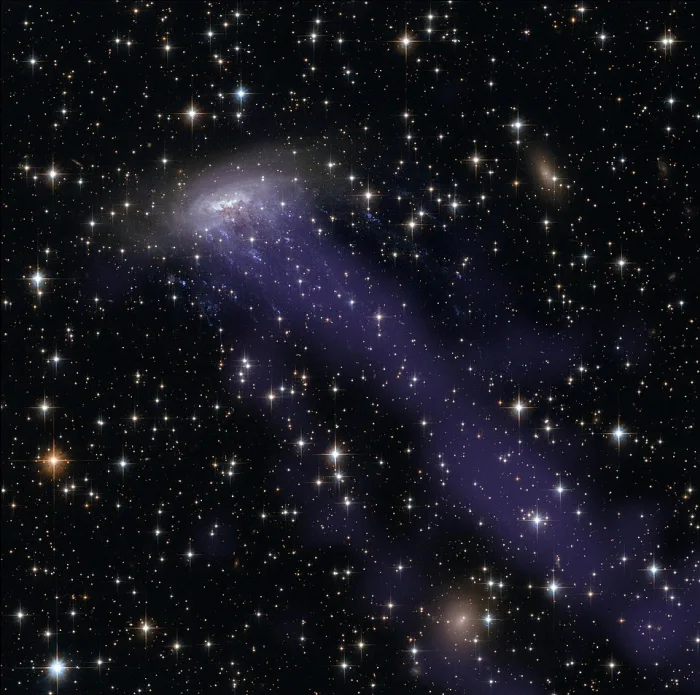
This image combines NASA/ESA Hubble Space Telescope observations with data from the Chandra X-ray Observatory. As well as the electric blue ram pressure stripping streaks seen emanating from ESO 137-001, a giant gas stream can be seen extending towards the bottom of the frame, only visible in the X-ray part of the spectrum. Credit: NASA, ESA, CXC (CC BY 2.0)
Like many other jellyfish galaxies, ESO 137-001 has a high star formation rate relative to the low amount of neutral hydrogen it contains. Star formation in jellyfish galaxies takes place both in the stripped tails and in the galactic disks because the ram pressure in most galaxy clusters is not strong enough to strip the dense clouds of molecular gas in which stars form.
Recent studies have demonstrated that ordered magnetic fields play an important role in facilitating star formation in the hot, diffuse stripped gas. They prevent heating, allowing neutral gas to cool.
In 2024, observations with the MeerKAT radio telescope array in the Northern Cape province of South Africa revealed the presence of neutral atomic hydrogen (HI) in both the galactic disk of ESO 137-001 and in the outer regions. The astronomers found a total HI mass of (3.5 ± 0.4) × 108 M⊙, which makes the galaxy exceptionally HI deficient. The team proposed that the galaxy lost 90% of its neutral hydrogen through gas stripping. About two thirds of the remaining HI forms the 40 kpc-long tail. Around 10% of the surviving neutral hydrogen was still detected in the stellar disk.

Composite X-ray/optical image of ESO137-001’s tail, Right: Velocity map of 33 H II regions derived from the Gemini data. Reproduced by permission of the AAS. Credit: NOIRLab (CC BY 4.0)
Facts
The Jellyfish Galaxy was discovered by Dr. Ming Sun based on observations with the Chandra X-ray Observatory and the XMM-Newton X-ray Observatory in 2005. The discovery of the galaxy and its 70-kpc tail visible at X-ray wavelengths was reported in The Astrophysical Journal in 2006.
Subsequent observations with the Southern Astrophysical Research (SOAR) telescope revealed a Hα tail about 40 kiloparsecs (130,462 light-years) long extending away from the galaxy’s disk. The tail points away from the centre of the Norma Cluster. It was imaged by the Multi Unit Spectroscopic Explorer (MUSE) on the Very Large Telescope (VLT) at the European Space Observatory (ESO) in Chile in 2014 and 2023.
The 2023 observations with MUSE showed that the warm, ionized gas stretches at least 87 kpc (283,756 ly) from the galaxy and splits into three tails. A study based on observations with MUSE, Hubble and the ALMA (Atacama Large Millimeter Array) interferometer found that many blue regions in the galaxy had an age of less than 10 million years. Astronomers estimated a total star formation rate of around 1.2 solar masses per year, which is less than in many other jellyfish galaxies. The galaxy has lost more HI gas than many of its jellyfish counterparts.
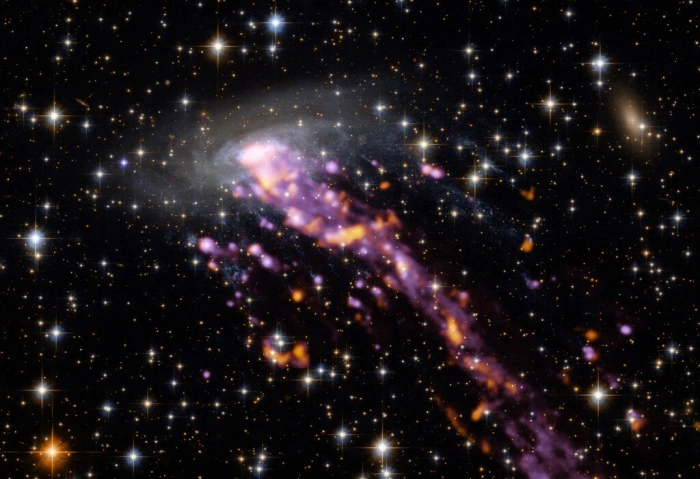
Using the detailed eyes of the Atacama Large Millimeter/submillimeter Array (ALMA) and ESO’s Very Large Telescope (VLT), astronomers have mapped the intense tails of a cosmic jellyfish: a number of knotty streams of gas spewing outwards from a spiral galaxy named ESO 137-001. This celestial cnidarian is shown here in beautiful detail. The various elements making up this image were captured by different telescopes. The galaxy and its surroundings were imaged by the NASA/ESA Hubble Space Telescope; its tails, which trace streams of hydrogen and show up in hues of bright purple, by the MUSE instrument mounted on the VLT; and bright hotspots of carbon dioxide emission from within the system, which show up as flares of orange-red, were spotted by ALMA. These tails are caused by a dramatic phenomenon known as ram-pressure stripping. The space between galaxies in a cluster is not empty, but full of material that acts like a viscous fluid. As a galaxy travels through this resistant environment, gas is stripped out of the galaxy to form a wake that creates beautiful, intricate systems such as that seen here around ESO 137-001 (which resides in the Norma galaxy cluster). The direction and position of the tail shed light on the way in which the galaxy is moving — with galaxies usually falling towards the centre of the cluster itself. This image offers the first high-resolution map of the cold molecular gas lurking within a ram-pressure stripped system. ESO 137-001 is one of the nearest jellyfish galaxies to Earth, and is particularly interesting because its long, extended tails of gas contain features known as ‘fireballs’: bursts of star formation. The precise mechanisms governing how stars form within jellyfish tails are mysterious, and this map thus provides a new window onto the conditions needed for new stars to form in such intense, changeable environments. Credit: ALMA (ESO/NAOJ/NRAO), P. Jachym (Czech Academy of Sciences) et al. (CC BY 4.0)
The Norma Cluster, the host cluster of ESO 137-001, is a rich galaxy cluster that lies near the centre of the Great Attractor. The Great Attractor is the central gravitational point of the Laniakea Supercluster, which also contains the Virgo Supercluster, the home of the Milky Way and Andromeda galaxies, as well as the galaxies in the Virgo Cluster and about 100,000 other galaxies.
The Great Attractor lies behind the Zone of Avoidance (ZOA), the region of the sky heavily obscured by the Milky Way. The dust and gas in our galaxy blocks the visible light of background objects, making the Great Attractor and the Norma Cluster difficult to observe in visible light wavelengths.
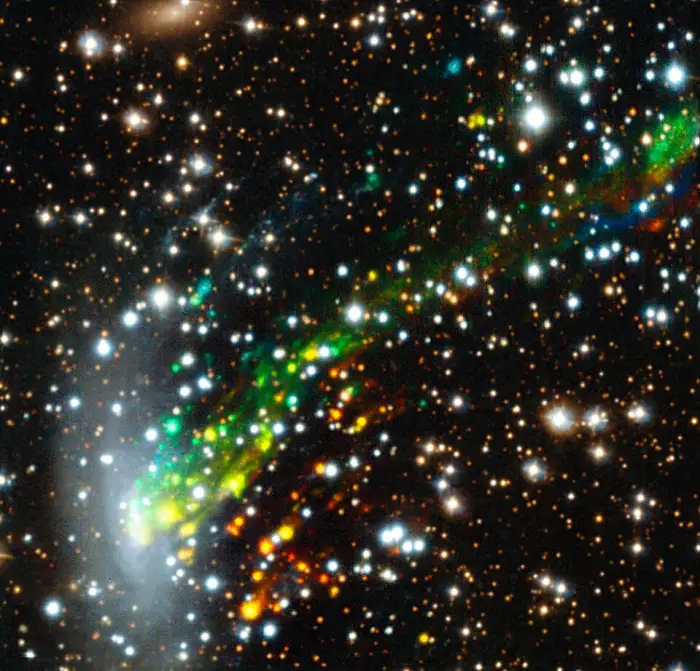
The MUSE instrument on ESO’s Very Large Telescope has provided researchers with the best view yet of a spectacular cosmic crash. Observations reveal for the first time the motion of gas as it is ripped out of the galaxy ESO 137-001 as it ploughs at high speed into a vast galaxy cluster. The results are the key to the solution of a long-standing mystery — why star formation switches off in galaxy clusters. In this picture the colours show the motions of the gas filaments — red means the material is moving away from Earth compared to the galaxy and blue that it is approaching. Note that the upper-left and lower-right parts of this picture have been filled in using the Hubble image of this object. Credit: ESO/M. Fumagalli (CC BY 4.0)
Location
The Jellyfish Galaxy lies in the far southern sky, near the conspicuous triangle that gives the constellation Triangulum Australe its name. It appears in the same region of the sky as the open clusters NGC 6025 (Caldwell 95) in Triangulum Australe and the S Normae Cluster (NGC 6087, Caldwell 89) in Norma. The galaxy cannot be observed in amateur telescopes.

Location of the Jellyfish Galaxy (ESO 137-001), image: Stellarium
Jellyfish Galaxy – ESO 137-001
| Constellation | Triangulum Australe |
| Object type | Barred spiral galaxy |
| Morphological type | SBc |
| Right ascension | 16h 13m 27.305s |
| Declination | −60° 45′ 50.59″ |
| Apparent size | 1.23′ × 0.55′ |
| Distance | 220 million light-years (67.45 megaparsecs) |
| Redshift | 0.015565 |
| Heliocentric radial velocity | 4630 ± 58 km/s |
| Size | 100,000 light years |
| Names and designations | Jellyfish Galaxy, PGC 57532, LEDA 57532, ESO 137-001, ESO 137-1, ESO-LV 137-0010, DENIS J161327.5-604549, IRAS 16091-6038, 2MASX J16132730-6045505, WKK98 6176 |
Images
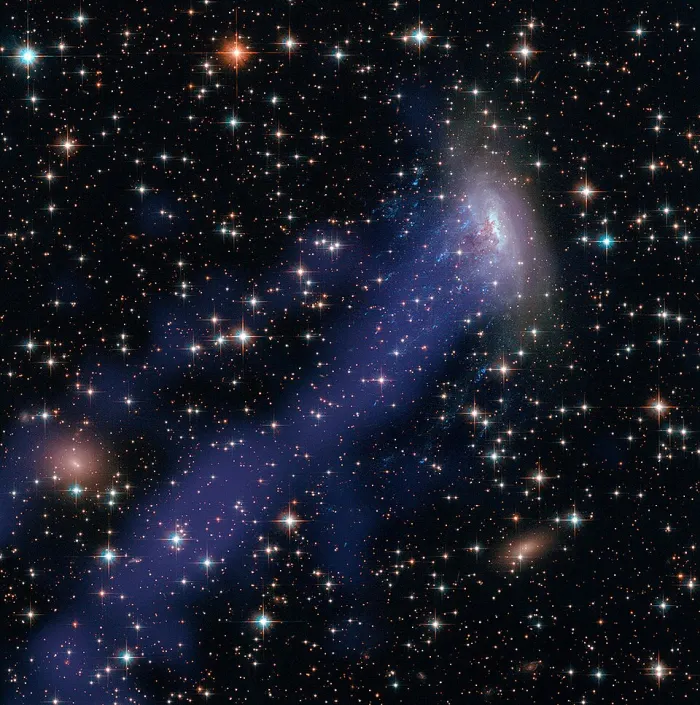
Composite image of the Jellyfish Galaxy – Hubble & Chandra, credit: NASA, ESA, CXC (CC BY-SA 4.0)
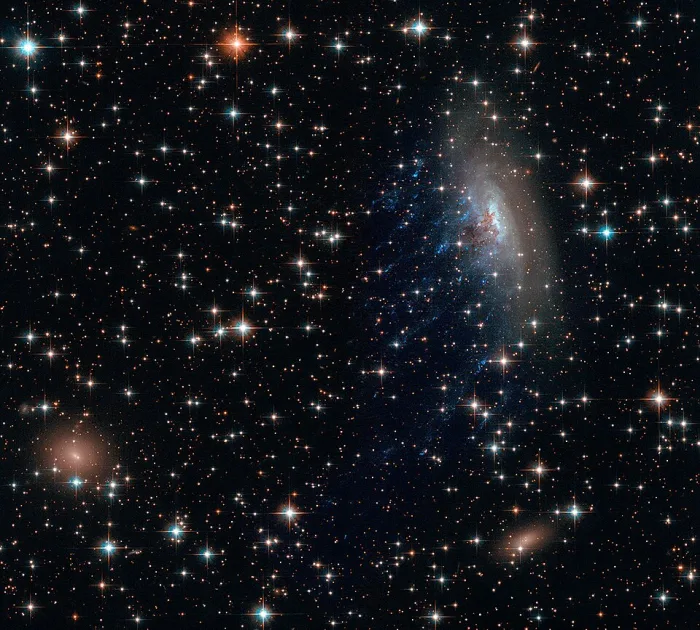
Jellyfish Galaxy by the Hubble Space Telescope, credit: NASA/ESA, Hubble (PD)
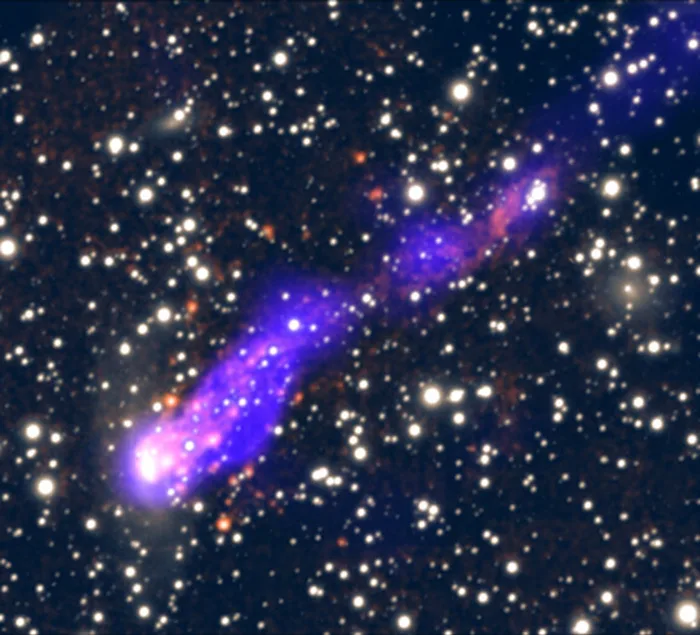
This composite image shows a tail that has been created as the galaxy ESO 137-001 plunges into the galaxy cluster Abell 3627. X-rays from Chandra (blue) and optical light (white and red) from the SOAR telescope show that as the galaxy plummets, it sheds material and is forming stars behind it in a tail that stretches over 200,000 light years long. This result demonstrates that stars can form well outside of their parent galaxy. Credit – X-ray: NASA/CXC/MSU/M.Sun et al; H-alpha/Optical: SOAR (MSU/NOAO/UNC/CNPq-Brazil)/M.Sun et al. (CC BY 4.0)